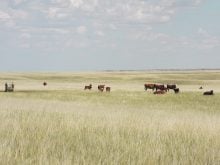Solid beef demand is turning into a good news story for the North American beef industry, says the senior analyst with Canfax.
Some volatility and risks remain but that can be managed, said Brian Perillat, senior market analyst with Canfax at the Canadian beef industry conference held in Calgary Aug. 13-16.
The futures markets have been cautious because of uncertainty over trade issues, weather and political upheaval. Yet consumers continue to buy beef and retail prices remain strong.
“We have seen a slight decrease in the demand increase but overall demand seems one of the strongest in the last 20 or 30 years,” he said.
Read Also

Charges laid after cattle theft
Saskatchewan RCMP lay two charges against a man after six cattle went missing.
There have been record export values of more than $3 billion this year.
The United States is the primary destination followed by Japan where exports are zooming upwards thanks to lower tariffs promised in the CPTPP.
Canadian beef production is increasing even though the national herd is not growing. Domestic production is up seven percent year over year with a 30 percent increase since 2015.
“That is even faster than the United States has. That points to a very competitive industry,” Perillat said.
Alberta cattle prices have been stable for the last few years and profitability remains for the cow-calf sector, where calves sell for $2-$2.20 per pound.
The fed market is another story where prices have hovered around $140 per hundredweight but are expected to drop to $130 cwt. before the fall is done. There could be continuing pressure on the Ontario fed market, which has lagged behind Alberta for months.
There is continuing demand for feeders but that may not last because feedlots have been in the red for some time.
“On a cash basis, there has not been much money in these cattle. They pay top dollar on their calves expecting a fairly strong market. If they can hedge, they can offset some of these losses,” he said.
“This is a bit of a concern with the volatility in the market and our fats going lower this fall. Profitability is going to drop some more in the feeding sector and they will only take that for so long,” he said.
“That is a risk to the calf market this fall. You can’t buy a feeder at today’s prices and hedge a profit,” he said.
He predicts 500-pound calves will be around $200 per cwt. this fall.
Expansion is a non-starter.
Dry conditions in the West discouraged producers from keeping heifers so they were placed on feed. More cows went to market in the spring and resulted in higher slaughter numbers.
“Our herd is not going to grow this year. We are probably going to see a bit more decline,” he said.
Canadian feeder exports are up seven percent. About 200,000 will likely go stateside but this is not a large amount compared to some years when close to half a million left.
Canadian feeder imports are up 50 percent with about 180,000 mostly Holstein calves arriving in southern Alberta for finishing. Those imports keep feedlots and packers at capacity even though the domestic herd has not grown.
The dollar is always a major factor and affects calf prices.
“Every time the dollar goes up one penny you can take five cents off calf prices,” Perillat said.
A strong basis level last year kept western Canadian fed prices above the United States but the cash-to-cash basis has fallen this spring to an $18-$20 discount.
On the feed grain side, barley prices are dropping and western crops have improved after lingering through drought.
This summer, Lethbridge barley was $6 a bushel. When barley values decline, calf prices improve.
“A dollar a bushel down helps calf prices by 20 cents,” he said.


















